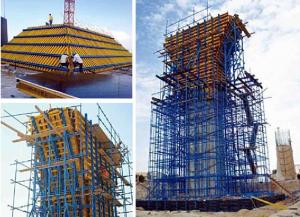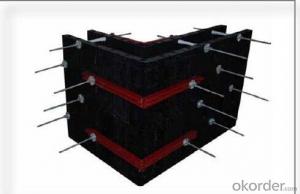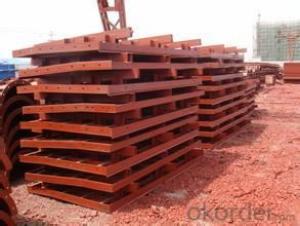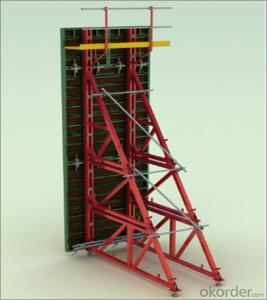Table formwork system and scaffolding system
- Loading Port:
- Tianjin
- Payment Terms:
- TT OR LC
- Min Order Qty:
- 50 m²
- Supply Capability:
- 1000 m²/month
OKorder Service Pledge
Quality Product, Order Online Tracking, Timely Delivery
OKorder Financial Service
Credit Rating, Credit Services, Credit Purchasing
You Might Also Like
Tabel Formwork:
Table formwork is the most typical application for slab, with timber beam, the slab formwork is
light weight, fast and economic in the construction.
Characteristics:
◆ Simple structure, easy assembly.
◆ Flexible structure, be adapted to different support system.
◆ High construction efficiency with special system tools.
1. Lifting fork for lifting the table formwork to upper floor.
2. Trolley for moving the table formwork on floor.
◆ Flexible application with stand alone props.
◆ Safer condition with handrails.
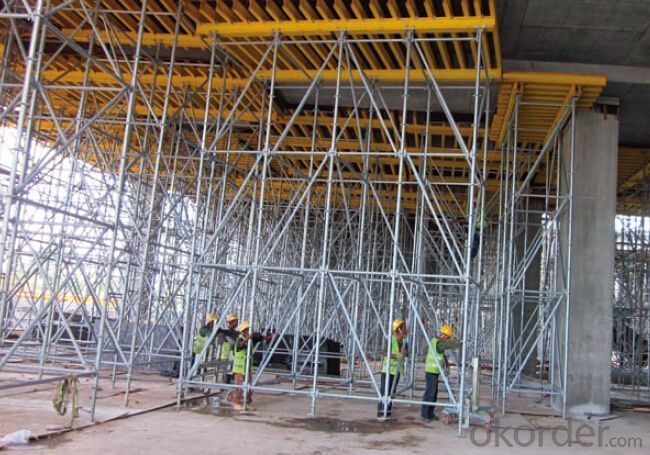
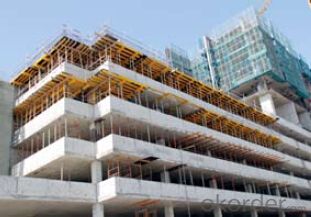
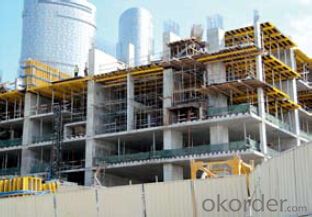
- Q:How does steel frame formwork ensure accurate dimensions and alignment?
- Steel frame formwork ensures accurate dimensions and alignment by providing a rigid and stable structure that holds the concrete in place during the construction process. The steel frames are precisely manufactured to the required dimensions, which helps in maintaining the shape and size of the concrete structure. Additionally, steel frame formwork allows for easy adjustment and alignment, ensuring that the concrete is poured accurately and in the desired position.
- Q:Problems and solutions of bamboo plywood formwork
- The main problems and reasons of bamboo plywood formwork(1) the thickness tolerance problem is not only used as the panel of the steel frame bamboo plywood, but also used as the veneer plywood.
- Q:Can steel frame formwork be used for residential buildings?
- Yes, steel frame formwork can be used for residential buildings. Steel frame formwork is a versatile and durable solution for constructing concrete structures, including residential buildings. It provides a strong and rigid framework that can withstand the pressure of concrete pouring and ensure accurate alignment and stability during the construction process. Additionally, steel frame formwork is reusable, which makes it a cost-effective choice for residential projects. It allows for faster construction and provides a smooth finish to the concrete structure. Overall, steel frame formwork is a suitable option for residential buildings due to its strength, durability, and efficiency.
- Q:Cross stitch mounting, with steel frame or wooden frame
- With the expansion tube, self tapping screws into the first, tapping screws do not fully drill into the back of the exposed 0.5cm,
- Q:How does steel frame formwork handle concrete pouring in hot weather conditions?
- Steel frame formwork is highly resistant to the effects of hot weather conditions during concrete pouring. The steel material has excellent thermal conductivity, which allows it to dissipate heat quickly, preventing the concrete from drying out too fast and reducing the risk of cracks or shrinkage. Additionally, steel formwork provides stability and structural support, ensuring that the concrete maintains its shape and strength even in high temperatures.
- Q:What are the maintenance requirements for steel frame formwork?
- The maintenance requirements for steel frame formwork involve several key aspects to ensure its optimal performance and longevity. First and foremost, regular cleaning is essential to remove any debris, concrete residue, or other materials that may accumulate on the steel frames. This can be done using water and mild detergent, followed by thorough drying to prevent rust formation. It is important to inspect the frames for any signs of corrosion or damage during the cleaning process. Additionally, lubrication of moving parts, such as hinges, joints, and locking mechanisms, is necessary to prevent friction and ensure smooth operation. Applying a suitable lubricant, such as silicone spray or grease, will help to prolong the lifespan of these components. Furthermore, the steel frame formwork should be stored in a dry and well-ventilated area when not in use. This helps to prevent moisture buildup, which can lead to rusting and degradation of the steel. It is advisable to keep the formwork elevated off the ground and protected from direct exposure to sunlight and extreme weather conditions, as these can also contribute to its deterioration. Regular inspections are crucial in identifying any signs of wear and tear, such as cracks, bent or misaligned parts, or loose connections. Any damaged or faulty components should be repaired or replaced promptly to maintain the formwork's structural integrity and safety. Lastly, proper handling and storage practices should be followed to prevent any accidental damage during transportation or when not in use. This includes avoiding excessive stacking, dropping, or mishandling of the steel frames. By adhering to these maintenance requirements, the steel frame formwork can be effectively preserved and continue to deliver reliable performance throughout its lifespan.
- Q:How does steel frame formwork handle the placement of concrete in overhead structures or ceilings?
- Steel frame formwork is specifically designed to handle the placement of concrete in overhead structures or ceilings efficiently and safely. The steel frame provides the necessary support and stability to ensure that the formwork remains in place without any deformation or collapse during the pouring and curing process. Additionally, the steel frame formwork allows for easy removal after the concrete has set, leaving a smooth and finished surface.
- Q:Can steel frame formwork be used for retaining walls or foundation structures?
- Yes, steel frame formwork can be used for retaining walls or foundation structures. Steel frame formwork is a flexible and durable solution that can withstand the pressure exerted by the concrete during the pouring process. It provides excellent support and stability, ensuring that the structure is strong and long-lasting. Additionally, steel frame formwork allows for easy installation, dismantling, and reusability, making it a cost-effective option for retaining walls and foundation structures.
- Q:How does steel frame formwork affect the overall aesthetics of a structure?
- Steel frame formwork can have a significant impact on the overall aesthetics of a structure. One of the main advantages of using steel frame formwork is its ability to create clean and smooth surfaces. The steel frames are designed to hold the concrete in place during the pouring process, ensuring that the finished structure has straight lines and sharp corners. Unlike traditional formwork materials such as wood, steel frame formwork does not warp or bend under the weight of the concrete. This results in a more uniform and visually appealing finish, as there are no visible imperfections caused by uneven formwork. Additionally, steel frame formwork allows for greater flexibility in design. The frames can be easily adjusted and modified to accommodate complex shapes and intricate details, giving architects and designers more freedom to create unique and visually striking structures. This versatility is especially important in modern architecture, where aesthetics play a crucial role. Moreover, the use of steel frame formwork can also have a positive impact on the durability and longevity of a structure. Steel is a highly robust material that can withstand harsh weather conditions and resist corrosion, ensuring that the formwork will maintain its structural integrity over time. This durability contributes to the overall aesthetics of the structure, as it allows for a long-lasting and visually pleasing appearance. In conclusion, steel frame formwork enhances the overall aesthetics of a structure by providing clean and smooth surfaces, allowing for greater design flexibility, and ensuring durability and longevity. Its ability to create visually appealing finishes and maintain structural integrity makes it a preferred choice for architects and designers seeking to achieve aesthetically pleasing results.
1. Manufacturer Overview |
|
|---|---|
| Location | |
| Year Established | |
| Annual Output Value | |
| Main Markets | |
| Company Certifications | |
2. Manufacturer Certificates |
|
|---|---|
| a) Certification Name | |
| Range | |
| Reference | |
| Validity Period | |
3. Manufacturer Capability |
|
|---|---|
| a)Trade Capacity | |
| Nearest Port | |
| Export Percentage | |
| No.of Employees in Trade Department | |
| Language Spoken: | |
| b)Factory Information | |
| Factory Size: | |
| No. of Production Lines | |
| Contract Manufacturing | |
| Product Price Range | |
Send your message to us
Table formwork system and scaffolding system
- Loading Port:
- Tianjin
- Payment Terms:
- TT OR LC
- Min Order Qty:
- 50 m²
- Supply Capability:
- 1000 m²/month
OKorder Service Pledge
Quality Product, Order Online Tracking, Timely Delivery
OKorder Financial Service
Credit Rating, Credit Services, Credit Purchasing
Similar products
New products
Hot products
Related keywords




















